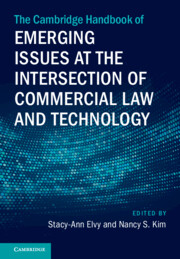Book contents
- The Cambridge Handbook of Emerging Issues at the Intersection of Commercial Law and Technology
- The Cambridge Handbook of Emerging Issues at the Intersection of Commercial Law and Technology
- Copyright page
- Epigraph
- Contents
- Figures
- Tables
- Contributors
- Preface
- Acknowledgments
- Part I Contemporary Technological Developments
- Part II The Implications of Emerging Product Design and Business Models
- 8 E-Commerce Platforms as Product Merchants and Sellers
- 9 3D Printing
- 10 The Right to Repair, Intellectual Property, Exhaustion, and Preemption
- 11 Repairing the Third Wave of Computing
- 12 Ending Smart Data Enclosures
- 13 Behavioral Implications and Emerging Legal Issues in Innovative and Digital Product Design
- Part III Contracting and Dispute Resolution
- Index
10 - The Right to Repair, Intellectual Property, Exhaustion, and Preemption
from Part II - The Implications of Emerging Product Design and Business Models
Published online by Cambridge University Press: 08 February 2025
- The Cambridge Handbook of Emerging Issues at the Intersection of Commercial Law and Technology
- The Cambridge Handbook of Emerging Issues at the Intersection of Commercial Law and Technology
- Copyright page
- Epigraph
- Contents
- Figures
- Tables
- Contributors
- Preface
- Acknowledgments
- Part I Contemporary Technological Developments
- Part II The Implications of Emerging Product Design and Business Models
- 8 E-Commerce Platforms as Product Merchants and Sellers
- 9 3D Printing
- 10 The Right to Repair, Intellectual Property, Exhaustion, and Preemption
- 11 Repairing the Third Wave of Computing
- 12 Ending Smart Data Enclosures
- 13 Behavioral Implications and Emerging Legal Issues in Innovative and Digital Product Design
- Part III Contracting and Dispute Resolution
- Index
Summary
The right to repair not only has important consumer value by preserving the useful life of existing products, but it also has additional and important social value by conserving natural resources and reducing pollution. However, the consumer right to repair in recent years has come under threat through the overextension by intellectual property (IP) doctrines that avoid current limits on antitrust liability by leasing or licensing rather than selling products to avoid “exhausting” IP rights and by applying IP rights to smaller portions of overall sold products, thereby treating parts rehabilitation or parts supply as prohibited acts of making or importation. Constitutional conflicts preemption might address some of these concerns, but federal legislation also is needed to protect consumers’ right to repair their purchased products.
- Type
- Chapter
- Information
- The Cambridge Handbook of Emerging Issues at the Intersection of Commercial Law and Technology , pp. 215 - 229Publisher: Cambridge University PressPrint publication year: 2025

